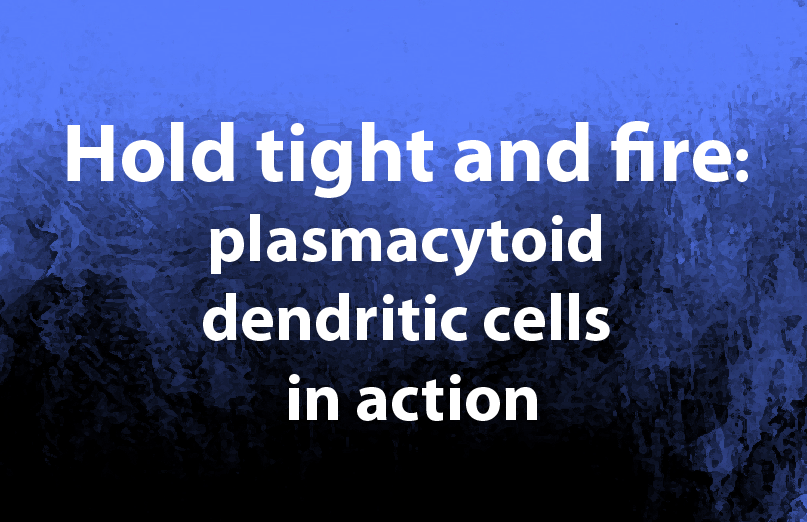Immunity vs. viruses
In our evolutionary arm race against invading viruses, our body has evolved multiple defensive mechanisms. Together with anti-viral, cell-intrinsic innate response mechanisms, alternative or indirect pathogen-sensing pathways are also employed in an organism attempt to outsmart the viral evasion countermeasures.
Plasmacytoid dendritic cells (pDCs): Specialist sentinels
Plasmacytoid dendritic cells (pDCs) are a specialized subset of dendritic cells that function as sentinels. When pDCs recognize viral pathogens, they can release large amounts of Type I interferon (IFN-I), thereby inducing a strong antiviral state that stops viral replication and ultimately promotes apoptosis of the virally infected cells.
Touching base and interrogation
pDCs sense viruses through physical contact with infected cells. This contact mechanism seems necessary because pDCs are resistant to most viral infections, possibly because they constitutively express interferon regulatory factor 7 (IRF7) (1). So, when cells more susceptible to infection are targeted by an invading virus, pDCs intervene. In their recent work, Assil and colleagues sought to define how this contact between pDCs and infected cell is established, ultimately leading to IFN-I activation.
Who are the key players in the contact between pDCs and infected cells?
First, the authors analyzed the expression and role of the cell adhesion complexes found on the pDCs surface: L-selectin, αL integrin, and intracellular adhesion molecule (ICAM-1). Through an antibody-mediated blocking assay, Assil et al. found that the inhibition of both αL integrin and ICAM-1 blocked the contact of pDCs with dengue-infected cells and, consequently, led to inhibition of the pDC IFN response in a dose-dependent manner. Next, in the same culture the authors mixed dengue infected GFP- cells and uninfected GFP+ cells together with pDCs. Indeed, they found that pDCs response prevented viral spread from GFP-DENV infected cells to GFP+ uninfected cells. However, when the physical contact between pDCs and the infected cells was inhibited through blockage of αL integrin and the ICAM-1 complex, viral propagation was restored to levels comparable to those in the absence of pDCs. This indicates that the establishment of cell contact through the αL integrin and ICAM-1 complex is required for the sensing of DENV infected cells by pDCs, leading to a potent antiviral response.
Similar contact but different viral antigens: Dengue, hepatitis C, and Zika
The requirement for cell contacts with infected cells is not only valid for dengue, but it is also pivotal for other viruses, such as hepatitis C virus (HCV) and Zika, as tested by the authors. This is particularly relevant because these viruses activate pDCs via different pathogen-associated molecular patterns (PAMPs) carriers. Notably, for hepatitis C virus (HCV), infected cells secrete exosome-like vesicles containing viral elements that efficiently trigger pDC IFN production (2). Instead, the activation of pDCs by dengue- or Zika infected cells is mediated by noninfectious viral particles that contain the viral envelope proteins at their surface (3). So, once that the cells have established a physical contact, different presenting antigens can activate the IFN response needed for viral clearance.
Getting together: pDCs and infected cells
When pDCs and infected cells get together, αL integrin specifically accumulates at the contact site on the pDCs membrane, where it forms a complex with β2 integrins. The interaction between these two integrins allows a conformational rearrangement that favors high-affinity interaction with the ligand partner ICAM-1, which is found on the surface of infected cells. The engagement of integrins with their ligand induces the local recruitment of the actin network via the Arp2/3 complex, a central actin nucleator that creates a complex cortical actin network beneath membranes. The authors tested the functional role of actin regulators, including Arp2/3 complex, the Rho GTPase CDC42 the phosphoinositide PI(4,5)P2, and found that their pharmacological inhibition prevented infected cells induced IFN production by pDCs. These findings suggeste that the cell polarity achieved through integrin-mediated rearrangement at the contact of the actin network is a primary feature of how pDCs ensure an efficient antiviral response.
How does contact between pDC and dengue-infected cells prevent viral propagation?
Co-clusters of PI(4,5)P2, Early Endosome Antigen1 (EEA1), and clathrin together with actin were observed on the pDC side of the contact with infected cells, indicating that components of the endocytosis machinery polarize where the contact occurs, acting as a structural platform for the concentration of PAMP carriers, thus facilitating their efficient transmission to the pDCs, and ultimately leading to TLR-mediated activation of the IFN response. Since PAMP recognition by TLR7 is known to occur in the endolysosome compartment, it is possible that the immature virions (i.e., those incompetent for membrane fusion) are likely retained in this TLR7-containing endolysosome compartment, resulting in a potent TLR7-mediated IFN response by the pDCs, as opposed to mature particles, which likely escape TLR7 recognition by membrane fusion.
Sticking together
In their final analyses, Assil et al. also show that pDCs make longer-lived contacts with infected cells than non-infected cells. Using a TLR7 inhibitor and agonist, the team also show that this sticking-together is a result of feed-forward regulation via TLR7 signaling and that this involves a polarity of regulators of adhesion, the actin network, and endocytosis machinery. A well coordinated effort specifically evolved to keep viruses at bay.
References
- Swiecky et al., Plasmacytoid dendritic cell ablation impacts early interferon responses and antiviral NK and CD8(+) T cell accrual, Immunity, 2010
- Feng et al., Human pDCs preferentially sense enveloped hepatitis A virions, J Clin Invest. 2015
- Décembre et al., Sensing of immature particles produced by dengue virus-infected cells induces an antiviral response by plasmacytoid dendritic cells, PLoS Pathog. 2014




